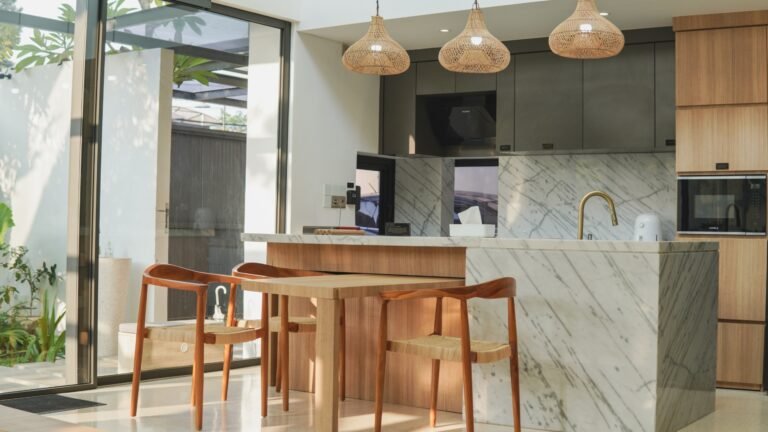
Thinking Of A New Dining Table? Here’s How Marble And Timber Compare
Choosing a dining table is about far more than filling an empty spot in the dining room. It is where families gather, conversations unfold, and memories are created over everyday meals and special occasions. That is why selecting the right table goes beyond appearance — it is a decision shaped by lifestyle, durability, and long-term investment. Among the most enduring options, the marble vs timber dining table debate continues to spark curiosity among homeowners. Should you lean towards marble’s sleek sophistication or timber’s warm character? In this blog, we’ll compare the two in terms of aesthetics, durability, practicality, cost, and overall feel, so you can make a choice that perfectly suits your home.
Aesthetic Appeal: Classic Elegance vs Warm Character
When it comes to visual impact, marble tables bring an undeniable sense of refinement. With their smooth, cool surfaces and intricate veining, each piece of marble is unique, almost like nature’s artwork on display. A marble dining table naturally becomes the focal point of a room, pairing beautifully with modern interiors, open spaces, and minimalist settings.
On the other hand, a timber dining table radiates warmth and approachability. Its organic texture and visible grain patterns instantly add depth and coziness to interiors, making it especially appealing in family homes or spaces designed to feel inviting. Timber also adapts beautifully across design styles — from rustic farmhouse to Scandinavian minimalism or sleek contemporary spaces.
In short:
- Marble: luxurious, striking, and contemporary.
- Timber: warm, versatile, and timeless.
Both have strong aesthetic appeal, but your choice will depend on whether you want a bold statement piece or a table that blends seamlessly into everyday life.
Durability and Maintenance: Longevity in Daily Life
Durability often defines whether your dining table remains a family heirloom or needs replacement after a few years. Marble is renowned for its strength, but it is also a porous material. This means it is vulnerable to stains from wine, sauces, and even water if not properly sealed. It can also scratch or chip with heavy use, which makes regular upkeep necessary to maintain its pristine look.
Timber, by contrast, is celebrated for its resilience and adaptability. Yes, it can scratch or dent, but these marks often add character rather than diminishing its value. Unlike marble, timber can be repaired — polished, refinished, or sanded down — making it a practical long-term choice. A well-maintained timber table can last generations, evolving with the home while retaining its charm.
Ultimately:
- Marble offers durability but requires careful handling and sealing.
- Timber is more forgiving and easier to maintain in daily life.
Practicality and Lifestyle Considerations
Your lifestyle plays a huge role in deciding which material suits you best.
A marble table works wonderfully in homes that value formality and design-forward aesthetics. It is ideal for those who entertain guests often or want a piece that feels like a sculptural centerpiece. However, marble is heavy, which means it is not easy to move around, and its upkeep might not suit busy households with young children.
A timber table, on the other hand, is more adaptable to everyday living. It fits comfortably into homes with kids or pets, where spills and scratches are bound to happen. Timber’s lighter weight compared to marble also makes it easier to move or rearrange when re-styling a space.
If you’re after practicality:
- Marble = statement-making, less forgiving.
- Timber = family-friendly, adaptable, and flexible.
Cost Comparison: Investment vs Versatility
Budget often becomes the deciding factor, and here, marble and timber differ significantly.
Marble dining tables are generally premium investments. They come at a higher upfront cost, but their rarity and distinctive appeal justify the price for many buyers. A marble piece can last decades if maintained, though repairs are more expensive if damage occurs.
Timber dining tables, meanwhile, are available across a wide spectrum of price points. From affordable options made with engineered woods to solid hardwoods that command higher prices, timber offers flexibility to suit different budgets. Moreover, repairs and refinishing are cost-effective compared to marble restoration.
In essence:
- Marble = higher investment, long-term luxury.
- Timber = versatile pricing, easier maintenance costs.
Texture, Finish & Customisation Options
Beyond strength and style, texture plays a major role in how a dining table feels within a home.
Marble has a smooth, cool surface with veining that ensures no two tables are ever alike. Finishes such as polished marble offer a high-gloss look, while honed finishes provide a softer, matte appearance. Both options elevate the space with a touch of refinement.
Timber, on the other hand, thrives on its organic texture. Its natural grain patterns bring warmth and individuality, with no two tables looking identical. Timber allows for remarkable customization — from matte or raw finishes that emphasize its rustic charm to glossy or stained surfaces that feel more contemporary. This flexibility makes it easy to align a timber table with different design visions.
The finish you choose, whether marble’s sleek polish or timber’s inviting grain, can completely shape the mood of your dining area.
Conclusion
At the end of the day, both marble and timber bring something unique to the dining room. Marble impresses with its sleek, dramatic flair that elevates any setting into something memorable. Timber, in contrast, offers warmth, adaptability, and a family-friendly nature that grows with your household over time.
The decision isn’t about which is universally better, but which aligns with your needs, lifestyle, and sense of style. If you want a long-term investment that doubles as a centerpiece, marble may be your answer. If you’re looking for comfort, versatility, and durability that blends with daily life, timber might be the smarter choice.
So, what is the best material for dining table? The answer depends on whether you want refined luxury or lived-in comfort — either way, you’re choosing a timeless piece that will shape your dining experiences for years to come.



